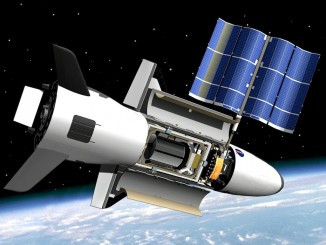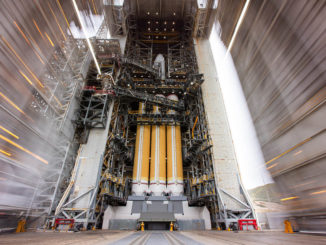
The U.S. Air Force’s next GPS navigation satellite met its ride into space this week with the spacecraft’s bolting on top of a United Launch Alliance Delta 4 rocket at Cape Canaveral in preparation for liftoff Aug. 22.
The spacecraft, built by Lockheed Martin, traveled from the Astrotech payload processing facility in Titusville, Florida, on an over-the-road transporter to Cape Canaveral’s Complex 37 launch pad. Teams there raised the satellite, already inside its payload shroud, on top of the Delta 4 rocket to begin the final steps of the integrated launch campaign.
Liftoff on Aug. 22 is scheduled for a 27-minute window that opens at 9 a.m. EDT (1300 GMT), four weeks later than previously planned.
ULA delayed the Delta 4 launch, along with the next flight of the company’s Atlas 5 launcher, to ensure the vehicles are free of a flaw that caused an unusual voltage measurement of an unspecified upper stage component during ground testing at the part’s supplier.
The Atlas 5 launch from Cape Canaveral is now scheduled for next Thursday, Aug. 8, with the Air Force’s fifth AEHF satellite to provide secure communication links for the military and government leaders.
The Atlas 5 mission next week will be ULA’s third launch of the year, followed two weeks later by the company’s fourth flight of 2019, when the Delta 4 takes off from Florida’s Space Coast.
The GPS 3 SV02 navigation satellite, nicknamed “Magellan,” arrived at the Florida spaceport in March for final launch preparations. The Air Force said the spacecraft passed final checkouts inside the Astrotech payload processing facility before encapsulation in late June.
The GPS network provides positioning and timing services worldwide for military and civilian users, beaming signals relied upon by airliners, ATMs, drivers and smart bombs, among numerous other users.

The Delta 4 launch Aug. 22 will be be the final flight of the Delta 4-Medium rocket variant, which flies with a single first stage booster, with additional thrust provided by strap-on solid rocket boosters. Two strap-on solid boosters are necessary to help get the GPS navigation satellite into its targeted orbit more than 12,000 miles (about 20,000 kilometers) above Earth.
The Delta 4-Heavy rocket configuration, made by combining three Delta 4 rocket cores together, will continue flying into the 2020s. The National Reconnaissance Office, using the Air Force as a contracting agent, has contracts in place for five more Delta 4-Heavy missions through 2024.
ULA decided in 2014 to retire the Delta 4-Medium configuration because it is more expensive than the company’s Atlas 5 rocket. The two rocket families are also largely redundant, but ULA kept the Atlas and Delta lines flying to ensure the Air Force had two rocket options to get military payloads into space.
There is no heavy-lift variant of the Atlas 5 rocket, so the Delta 4-Heavy will continue to fly into the 2020s, until ULA’s next-generation Vulcan launcher is operational.
The retirement of the Delta 4-Medium rocket also marks the last flight of the Delta 4’s 4-meter-diameter (13.1-foot) payload fairing. The Delta 4-Heavy rockets set for launch over the next five years all use a larger 5-meter (16.4-foot) payload shroud.
SpaceX’s Falcon 9 and Falcon Heavy rocket are now certified to fly the military’s national security satellites, providing the Air Force with a second family of launch vehicles alongside the Atlas 5 and Delta 4-Heavy.
The first of the new series of GPS 3 satellites, named “Vespucci,” launched in December aboard a Falcon 9 rocket.
Email the author.
Follow Stephen Clark on Twitter: @StephenClark1.



